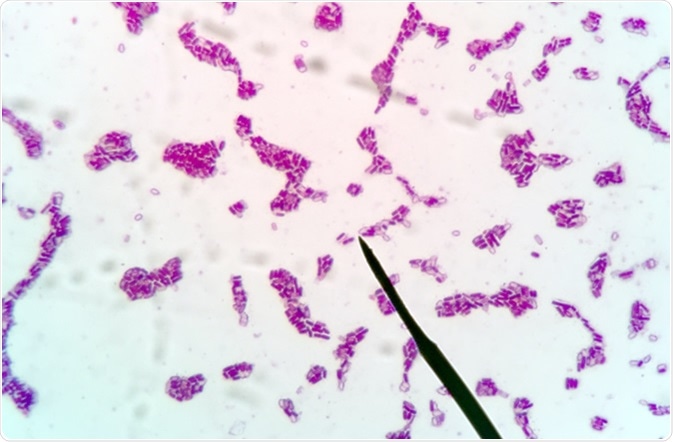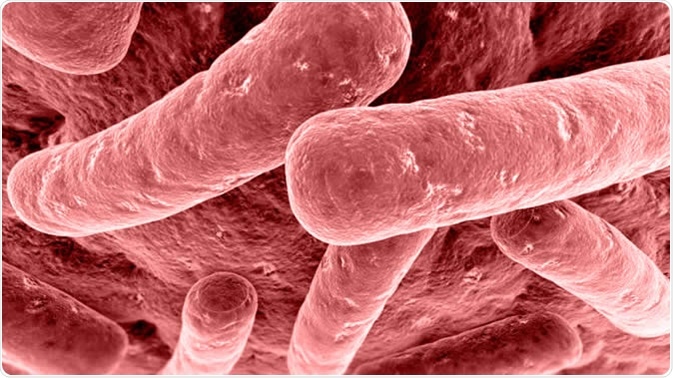Skip to:
Botulism is a rare but fatal disease caused by botulinum toxins released from Clostridium botulinum bacteria. Botulism is categorized into five different forms: foodborne botulism, wound botulism, infant botulism, inhalation botulism, and iatrogenic botulism.

Clostridium botulinum gram stain. Image Credit: Patiyurh Sirisukpokar / Shutterstock
What is botulism?
Botulism is caused by botulinum toxins that attack the nervous system, leading to impaired nerve functioning, respiratory problems, muscle paralysis, and even death. The causative bacteria are generally present in the nature in their dormant forms (spores), which are resistant to adverse environmental conditions. The bacteria start germinating and producing toxins when exposed to specific conditions, such as low oxygen, low acidic, low sugar, and low salt conditions.

Botulism is a potentially fatal condition that is caused by a bacterium called Clostridium botulinum.
Botulinum toxins are of 7 different types (A – G); of which, types A, B, E, and F (rarely) are responsible for human botulism. Other mammals, such as birds and fish, are mainly affected by types C, D, and E. It is the toxin, and not the bacteria itself, that causes the disease of botulism.
Foodborne botulism is caused by ingestion of toxin-contaminated food. The bacteria germinate and produce toxins in food products that are poorly cooked or inappropriately preserved (for example, improperly heated and canned vegetables). The symptoms usually start appearing within 12 – 36 hours of exposure. The most common symptoms include weakness, extreme fatigue, blurred vision, dry mouth, speaking difficulty, and gastrointestinal problems.
Infant botulism is caused by ingestion of bacterial spores, which subsequently germinate and produce toxins inside the gastrointestinal tract. The most frequent source of spores is contaminated honey. The disease mainly occurs in infants under 6 months of age.
Common symptoms include constipation, loss of appetite, weakness, and loss of head control. Infants less than 12 months of age do not have sufficient stomach acid to kill botulism spores. Honey may contain botulism spores from the environment. Therefore, children under the age of 1 year should never consume honey.
Wound botulism mainly occurs when bacterial spores get into an open wound and produce toxins. People who take illicit drugs are at higher risk because of frequent compromise of the skin and use of unclean injection drug paraphernalia. The disease may also occur after traumatic injuries or surgeries. The symptoms start appearing within 2 weeks of exposure and are similar to that of foodborne botulism.
Inhalation botulism is caused by inhalation of air that is contaminated with bacterial toxins. This type of botulism is highly unlikely and is limited to accidental exposures in laboratory settings or could occur with intentional bioterrorism attacks. The symptoms start appearing within 1 – 3 days of toxin inhalation.
Iatrogenic botulism occurs due to accidental injection of high-dose commercial botulinum toxins (Botox) into the blood. Botox is indicated to treat certain neurologic disorders. People should only receive Botox treatment from licensed healthcare providers who are trained in the appropriate and safe use of this medication.
How is botulism is diagnosed?
The diagnosis is initially made from patient’s clinical history and clinical characteristics of the infection. The laboratory confirmation is carried out by analyzing the presence of toxins or bacteria in biological samples, such as stool or blood.
Since the symptoms of botulism are similar to certain diseases (Guillain-Barré syndrome, stroke, myasthenia gravis, and stroke), doctors sometimes perform brain scan, spinal fluid analysis, and nerve/muscle function tests to rule out other diagnoses.
How is botulism treated?
The standard of care for treating botulism is administration of antitoxin. It binds directly with the bacterial toxin and prevents it from causing more damage to the nervous system. However, the drug cannot heal the damage already done by the toxins. The mortality rates can be significantly reduced with an immediate antitoxin treatment. In infants, botulism is treated with an antitoxin called botulism immune globulin.
In wound botulism, surgery may be necessary to remove the affected tissue. Antibiotics may be indicated to limit growth of botulism and other co-infecting bacteria in wounds. However, antibiotics are not recommended for other botulism types because these medicines can increase the rate of toxin release.
If the botulism is associated with breathing difficulties, a mechanical ventilator may be used to help the patient breath normally until the severity of symptoms reduces gradually. After completion of the treatment, people who present with fatigue, speech problems, shortness of breath, and swallowing difficulties may need long-term rehabilitation for months or years to recover.
What are the preventive measures?
Foodborne botulism can be prevented by using proper food canning techniques. The best home remedy to ensure germ-free food processing is to pressure-cook the food at 121°C for 20 – 100 minutes, depending on the food item. Charts are readily available online to determine minimum cooking times needed for specific food items. Before serving, the food should be boiled for at least 10 minutes.
For proper storage of canned foods, it is important to follow the manufacturer’s instructions. Ensure storing the cold food below 5°C and hot food above 60°C, and avoid consuming food from broken, damaged, or bulging cans or bottles.
Low acidic foods, such as asparagus, green beans, beets, corn, and potatoes, are potential sources of foodborne botulism. Therefore, always ensure that foods are sufficiently acidic naturally or artificially (addition of acidic substances like lime juice, citric acid, or vinegar).
The risk of botulism can also be reduced by refrigerating the canned products after opening the seal. In addition, ensure refrigerating garlic/herb infused homemade oils and avoid keeping them for more than 4 days. If aluminum foils are used to wrap potatoes before baking, try consuming the potatoes hot, or refrigerate them after loosening the foil.
To avoid wound botulism, properly clean the wound. If the symptoms of infection appear in the wound site, immediately seek medical attention. In addition, avoid using injection or inhalational drugs, particularly in combination with dirty or already used equipment.
To avoid infant botulism, do not give honey to infants under the age of 1 year. To avoid iatrogenic botulism, get the safest dose of botulinum toxin injections from licensed professionals.
Further Reading